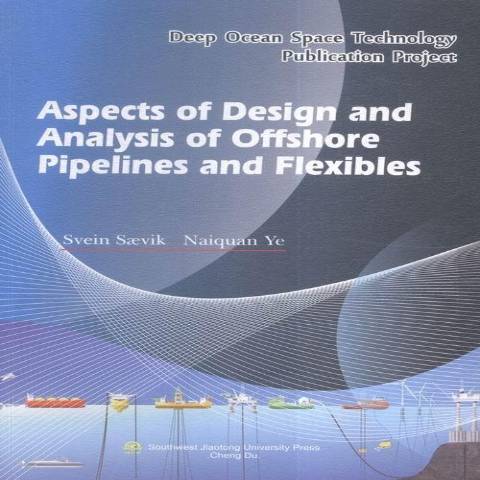《海洋工程柔立管與海底管道設計及分析》是2016年西南交通大學出版社出版的圖書。
基本介紹
- 中文名:海洋工程柔立管與海底管道設計及分析
- 作者:Svein S?vik、Naiquan Ye
- 出版社:西南交通大學出版社
- 出版時間:2016年
- 頁數:293 頁
- 開本:16 開
- 裝幀:平裝
- ISBN:9787564344665
內容簡介,圖書目錄,作者簡介,
內容簡介
《海洋工程柔性立管與海底管道設計及分析》主要針對柔性海洋結構和柔性管機械行為分析相關的有限元知識,與海洋立管相關的材料及其成型加工技術,海底管道熱傳導,海洋洋流載荷及海底土壤接觸約束條件,重點以海底鋪架管道、深海用柔性管道及其海底用臍帶管為主,從理論設計、套用等進行闡述,一次將這兩種管線的核心設計理念融合在一起闡述,將二者異同交叉闡述,既避免了重複闡述,又強調了這兩種管道的核心差異。《海洋工程柔性立管與海底管道設計及分析》具有鮮明的行業特點和獨創性及前沿性。
圖書目錄
CHAPTER 1 Introduction
1.1 General remarks
1.2 The design process
1.3 Engineerin8 phases
1.3.1 Steel pipelines
1.3.2 Flexible pipes
CHAPTER 2 Design Principles
2.1 General remarks
2.2 Design formats
2.3 Discussion of relevant loads
2.4 Discussion of failure modes
2.4.1 Mechanical failure modes for steel pipelines
2.4.2 Mechanical failure modes for flexible pipes.
2.5 Cross-section design
CHAPTER 3 Steel Pipeline Design
3.1 General remarks
3.2 Stress and strain components
3.3 Wall thickness design
3.3.1 The hoop stress (bursting) criteria
3.3.2 External pressure collapse
3.4 Design against other relevant failure modes in steel pipelines
3.4.1 Buckling due to combined loads
3.4.2 Fatigue
3.4.3 Other mechanical failure modes
CHAPTER 4 Mechanical Behaviour of Flexible Pipes
4.1 General remarks
4.2 Governing stress components
4.3 Wire geometries
4.4 Behaviour due to axi-symmetric loads
4.4.1 General
4.4.2 Axial loading
4.4.3 Torsion
4.4.4 Internal and external pressure
4.5 Behaviour in bending
4.5.1 General
4.5.2 Minimum bend radius
4.5.3 Stresses and stress resultants related to the tensile armour
4.5.4 Stresses related to the pressure armour
4.6 Buckling
4.6.1 Carcass collapse
4.6.2 Tensile armour buckling
4.7 Fatigue
4.7.1 General
4.7.2 Mean stress correction
4.7.3 Mean and dynamic stresses in the tensile armour
4.7.4 Mean and dynamic stresses in the pressure armour
4.7.5 The effect of corrosion failures in terms of bursting and fatigue performance
4.7.6 The effect of corrosion in terms of lateral wire buckling
4.7.7 The link between global and local analysis
4.8 Computational methods
4.8.1 General
4.8.2 Axi-symmetric stress analysis
4.8.3 Bending and fatigue stress analysis
4.8.4 Special cases
CHAPTER 5 Heat Transfer and Thermal Insulation
5.1 General remarks
5.2 The heat transfer coefficient
5.2.1 Conduction
5.2.2 Convection
5.2.3 Influence of soil burial
5.3 The temperature profile
5.4 Time to reach critical temperature
CHAPTER 6 Steel Pipeline Material Selection and Welding
6.1 General remarks
6.2 Material selection
6.3 Pipeline welding
6.3.1 General
6.3.2 Welding processes
6.3.3 Non-destructive testing
CHAPTER 7 Pipeline Installation
7.1 General remarks
7.2 Pipeline installation methods
7.2.1 Controlled depth tow method
7.2.2 J-lay
7.2.3 S-lay
7.2.4 Selection of method
7.3 Pipeline installation analysis
7.3.1 The effective tension concept and Archimedes law
7.3.2 The catenary equation
7.3.3 Minimum horizontal radius
7.3.4 Residual radius and roll
CHAPTER 8 Global Buckling
8.1 General remarks
8.2 The process of bucklin8
8.3 Analytical global buckling model
8.4 The significance of different parameters included in an upheaval buckling analysis
8.4.1 Formulation of the upheaval buckling failure function
8.4.2 Input parameters and failure function
8.4.3 The Hasofer-Lind reliability index
8.4.4 Results
CHAPTER 9 The Finite Element Method as Applied to Slender Structures
9.1 General remarks
9.2 Basics of the finite element method
9.3 Non-linear effects
9.4 Strain and stress measures
9.5 Non-linear finite element methods
9.5.1 Equilibrium equation
9.5.2 Non-linear formulations
9.5.3 Material law-plasticity for metals
9.5.4 Solution techniques
9.6 Description of some elements of general relevance for global analysis of slender structures
9.6.1 Oeneral
9.6.2 Pipe elements
9.6.3 Seabed contact element
9.6.4 Roller contact element
9.6.5 Pipe-in-pipe contact element
9.7 Description of elements related to global and local response of flexible pipes and umbilicals
9.7.1 Oeneral
9.7.2 Helical beam elements
9.7.3 Associated elements
CHAPTER 10 Modelling and Analysis Examples
10.1 General remarks
10.2 Dynamic simulation of S-lay
10.2. 1 Objectives
10.2.2 Input data
10.2.3 Modelling
10.2.4 Results
10.3 J-tubepull-in
10.3.1 Objectives
10.3.2 Input data
10.3.3 Modelling
10.3.4 Results
10.4 Pipeline walking
10.4.1 Objectives
10.4.2 Input data
10.4.3 Modelling
10.4.4 Results
10.5 Lateral buckling versus alternative soil models
10.5.1 Review of lateral soil models
10.5.2 Objectives
10.5.3 Input data and modelling
10.5.4 Results
10.6 Pipeline trawl-gear interaction loads
10.6.1 Oeneral remarks
10.6.2 Objectives
10.6.3 Input data
10.6.4 Modelling
10.6.5 Results
10.7 Stress behaviour of flexible riser at the platform hang-off
10.7.1 Objectives
10.7.2 Input data
10.7.3 Modelling
10.7.4 Results
10.8 Lateral buckling behaviour of tensile armours
10.8.1 Objectives
10.8.2 Input data
10.8.3 Modelling
10.8.4 Results
Bibliography
作者簡介
薩維克,has been a prnfessor of marine structures at the Norwegian University of Science and Technoloogy (NTNU) since 2009. He has decades of experience in pipeline engineering, covering most aspects of structural design and analysis of offshore pipeline systems. He has also spent more than 20 years working as a rescarcher focusing on development of models for stress and fatigue analysis of flexible pipes and umbilicals. Part of Ibis has been the development of several non-linear finite element codes for global and local analysis of pipelines, flexible pipes and umbilicals that arc widcly used by the industry. This includes the SIMLA program for global response analysis of pipelines, the BFLEX program fur stress anlysis of flexible pipes, the USAP program for stress analysis of large pitch length umbilicals and the UFLEX program for stress analysis of short pitch length umbilicals. Professor Savik has published a large number of journal and conference articles within these topics and received various awards for his work including the Statoil award.
葉乃全,has been working as senior research scientist at Norwegian Marine Technology Research Institute (MARINTEK) for more than 12 ycars since he graduated from the Department of Marine Structures at NTNU. Since then he has been extensively devoting his career in the development of numerical tools and methnds for stress analysis of flexible risers, umbilicals and pipelines. He has been the key personnel carrying out several joint industry program with aiming at developing of efficient and cost-effective solutions for flexible risers, umbilicals and pipelines. In addition, Dr.Ing Ye has been acting as project manager for numerous commercial projects from both oil and gas industry and new ocean energy sector, Dr.lng Ye has won twice the best paper award at MARINTEK for his outstanding research there.

